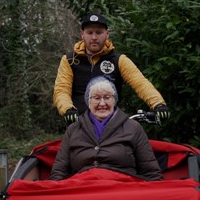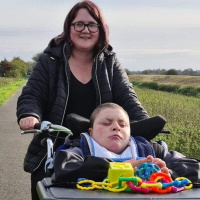Barriers on the National Cycle Network
Find out what barriers are, why they're there and how you can get a restrictive barrier redesigned.
We've created this guide to give you an understanding of why physical barriers exist and what the alternatives are. Along with the information and tools you may need to get a physical barrier redesigned or removed on the National Cycle Network.
As part of this guide you'll find the many benefits of barrier removal and redesign, and the positive impact this has on making traffic-free routes more accessible for everyone.
We've answered some of your common questions around physical barriers on the Network and we've put together a step-by-step guide on how to get barriers redesigned or removed.
Get in touch
Please direct all enquiries related to barriers on the National Cycle Network to pathsforeveryone@sustrans.org.uk.
About barriers

What are barriers?
Find out what barriers are, the different types you might come across, and learn about the issues they create for people using the National Cycle Network.

Why are there barriers on the National Cycle Network?
Barriers are often used to keep motor vehicles off walking and cycling routes. But they end up excluding a much wider group of people.
Find out why they're there and what the alternatives are.

More common questions
We've put together answers for some of the most common questions we receive around barriers.

Getting a restrictive barrier redesigned: Josh's story
Josh runs a free service which allows people with mobility issues to experience the joys of traffic-free routes through his trishaw rides.
When he encountered a restrictive physical barrier on the National Cycle Network on his trishaw, he was determined to find a solution to make the route accessible for all.
How to get barriers redesigned or removed

Guide to getting a barrier redesigned or removed
Getting a physical barrier redesigned on the Network is possible.
We’ve put together a step-by-step guide to assist you in your endeavours to help make traffic-free routes more accessible for everyone.
It’s important to note that each barrier redesign case is different and depending on the circumstance, not every step and recommendation in the guide will apply to the barrier(s) you’re looking at.

Common questions
We've answered some of the most common questions we receive around barriers.
What are the problem with barriers? And why do we need to remove them?
Or, what is the alternative to barriers?

New adventures on the Water Rail Way: Linda and Adam's story
Linda and her son Adam love getting outside to enjoy nature in the fresh air.
But when a barrier prevented the pair from using their local stretch of the National Cycle Network, Linda got in touch with Sustrans to change this.
Resources and guidance

Our resources
- What we're doing to make the Network more accessible for everyone.
- Our policy position statement on access controls.
- Our Barriers Strategy Action Plan.
- National Cycle Network design principles.
- Walking and cycling infrastructure design guidance.
- Our approach on access to routes.
- Why we need to redesign barriers on the National Cycle Network.
- The long-term impacts of barrier redesign – a
case study in York.

External resources
- Wheels for Wellbeing's guide to inclusive cycling.
- Beyond the Bicycle represents users of non-standard cycles. The group develops ideas to improve infrastructure, facilities and recognition for users of non-standard cycles in London.


